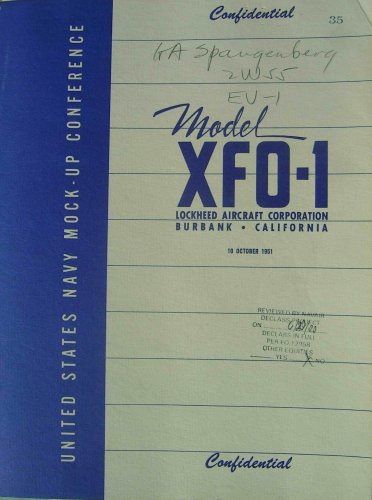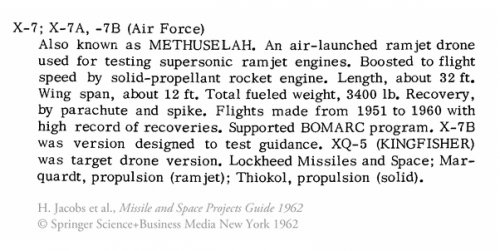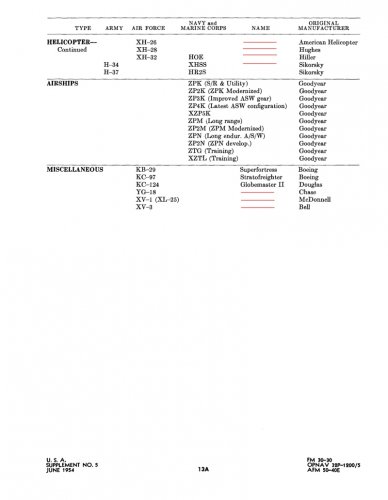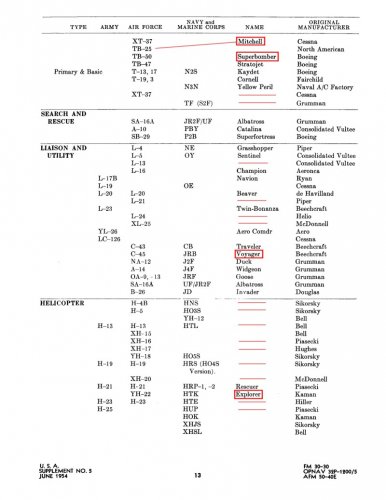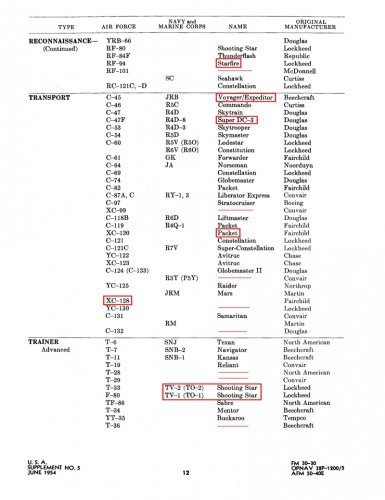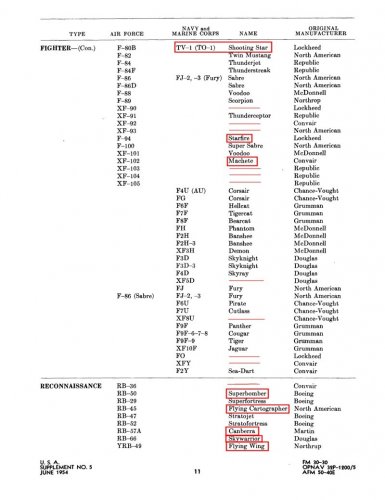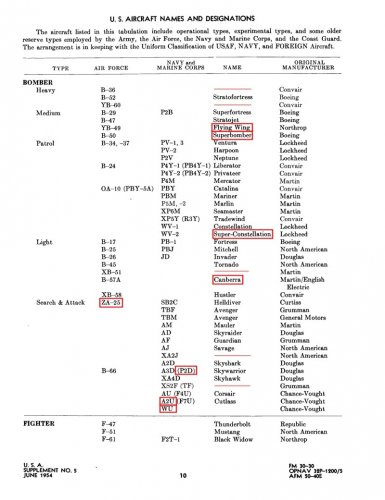The Grumman TF was a transport, not a trainer. Its official name was Trader. The ASW S2F was Tracker. The AEW WF-2 was Tracer.
You are using an out of date browser. It may not display this or other websites correctly.
You should upgrade or use an alternative browser.
You should upgrade or use an alternative browser.
Bogus aircraft names?
- Thread starter Stargazer
- Start date
The Navy FO designation is interesting. It reportedly was assigned by the Navy to some photo-reconnaissance P-38s that it operated in Europe in World War II. As far as I know, it was never used for the Navy's P-80s. See http://thanlont.blogspot.com/2012/02/navy-shooting-stars.html
The earliest documentation that I have for the XFV-1 is the SAC dated 1 October 1952. Since the change from O to V occurred before this, the XFV-1 should be represented in the June 1954 document like the XFY-1, and the addenda deletes it in favor of XFV-1, then FO may very well have been the original designation of the XFV-1. Or it may have been an error on the part of whoever compiled the document or provided the information on behalf of the Navy.
The earliest documentation that I have for the XFV-1 is the SAC dated 1 October 1952. Since the change from O to V occurred before this, the XFV-1 should be represented in the June 1954 document like the XFY-1, and the addenda deletes it in favor of XFV-1, then FO may very well have been the original designation of the XFV-1. Or it may have been an error on the part of whoever compiled the document or provided the information on behalf of the Navy.
This is clearly not my day for being right the first time. TF as a Transport, Grumman doesn't make sense because the transport mission designation would have been R or JR. For some reason, the Navy decided that it was best designated as a trainer rather than a transport (if all they wanted was a trainer, an S2F stripped of ASW mission equipment would have sufficed) and it was described as such on the SAC, with three of the five listed missions being training.
Attachments
- Joined
- 25 June 2009
- Messages
- 14,720
- Reaction score
- 6,044
Tailspin Turtle said:The Navy FO designation is interesting. It reportedly was assigned by the Navy to some photo-reconnaissance P-38s that it operated in Europe in World War II. As far as I know, it was never used for the Navy's P-80s. See http://thanlont.blogspot.com/2012/02/navy-shooting-stars.html
The earliest documentation that I have for the XFV-1 is the SAC dated 1 October 1952. Since the change from O to V occurred before this, the XFV-1 should be represented in the June 1954 document like the XFY-1, and the addenda deletes it in favor of XFV-1, then FO may very well have been the original designation of the XFV-1. Or it may have been an error on the part of whoever compiled the document or provided the information on behalf of the Navy.
The FO designation was indeed used twice: once for the recce Lightning and once as the early designation of the XFV-1.
I don't think I ever said anything that could give the impression it was used for the Shooting Star!!!
Stargazer2006 said:I don't think I ever said anything that could give the impression it was used for the Shooting Star!!!
And I didn't write that you did...
The Bushranger
ACCESS: Restricted
- Joined
- 24 January 2010
- Messages
- 11
- Reaction score
- 0
That's very odd indeed, given that P2D had already been assigned to a patrol version of the T2D torpedo bomber in 1930, and the XP3D had been the flyoff competitor to the famous PBY Catalina!Stargazer2006 said:
- A3D. Probably the most uncanny discovery in this document, a version was to be designated P2D![/l]
- Joined
- 25 June 2009
- Messages
- 14,720
- Reaction score
- 6,044
Bogus names strike again... The French Wikipedia has a page on the Boeing B-9 bomber and calls it the "Death Angel" throughout:
Boeing B-9 Death Angel - Wikipédia
Never even heard that one before in any Boeing book. It is sad, but what can one do?
Boeing B-9 Death Angel - Wikipédia
Never even heard that one before in any Boeing book. It is sad, but what can one do?
- Joined
- 29 August 2010
- Messages
- 598
- Reaction score
- 298
I had never heard of any nicknames for the B-9, but I looked at the English-language Wikipedia page and found an external link to an article from the August 1931 issue of "Modern Mechanics" magazine:Stargazer2006 said:Bogus names strike again... The French Wikipedia has a page on the Boeing B-9 bomber and calls it the "Death Angel" throughout:
Boeing B-9 Death Angel - Wikipédia
Never even heard that one before in any Boeing book. It is sad, but what can one do?
http://blog.modernmechanix.com/new-boeing-death-angel-to-be-worlds-fastest-bomber/
- Joined
- 25 June 2009
- Messages
- 14,720
- Reaction score
- 6,044
Fascinating, gatoraptor! I'm reposting the Modern Mechanics item here.
For all we know, the nickname may have been just a press ploy, not even company-given (Boeing rarely gave nicknames to his aircraft) and was certainly never quoted in any official Army Air Corps document.
For all we know, the nickname may have been just a press ploy, not even company-given (Boeing rarely gave nicknames to his aircraft) and was certainly never quoted in any official Army Air Corps document.
- Joined
- 25 June 2009
- Messages
- 14,720
- Reaction score
- 6,044
Although many would-be aircraft names have proved to be bogus afterthoughts, there are times when a type's REAL name has completely been overlooked.
Here is an item from Missile and Space Projects Guide by H. Jacobs et al (Springer, 1962) which clearly states that the Lockheed X-7's name was Methuselah!!!
Does anybody have an Air Force document that could back this one up? I have never seen it before. The book was highly authoritative in its own time and still is, so I don't believe it to be a mistake, but it would be nice to have some written proof, if only to determine if it was a Lockheed-given name, an Air Force-given name or a staff-given nickname...
Here is an item from Missile and Space Projects Guide by H. Jacobs et al (Springer, 1962) which clearly states that the Lockheed X-7's name was Methuselah!!!
Does anybody have an Air Force document that could back this one up? I have never seen it before. The book was highly authoritative in its own time and still is, so I don't believe it to be a mistake, but it would be nice to have some written proof, if only to determine if it was a Lockheed-given name, an Air Force-given name or a staff-given nickname...
Attachments
- Joined
- 19 February 2007
- Messages
- 1,433
- Reaction score
- 2,666
One X-7A airframe was nicknamed "Methuselah".
From a current eBay auction photo description:
"You are bidding on an original press photo from 1957 featuring 'BANKED' PURPOSELY - What appears to be a crash landing iS actually a Lockheed missile after making a parachute and nose-spike lending on U.S.Air Force desert range near Alamogordo, N.M., after completing its tenth flight for test purposes. Officially designated the TV-20 (test vehicle 20),it is a member of X-7 missile family. This one has been nick-named 'Methuselah" because of its long life. It is estimated, because this missile can be recovered and flown again, that each re-flight says tax-payers $390,000 in missile research costs, Thus "Methuselah," with its 10-flight, record has 'banked" $3,500 000."
From a current eBay auction photo description:
"You are bidding on an original press photo from 1957 featuring 'BANKED' PURPOSELY - What appears to be a crash landing iS actually a Lockheed missile after making a parachute and nose-spike lending on U.S.Air Force desert range near Alamogordo, N.M., after completing its tenth flight for test purposes. Officially designated the TV-20 (test vehicle 20),it is a member of X-7 missile family. This one has been nick-named 'Methuselah" because of its long life. It is estimated, because this missile can be recovered and flown again, that each re-flight says tax-payers $390,000 in missile research costs, Thus "Methuselah," with its 10-flight, record has 'banked" $3,500 000."
- Joined
- 18 March 2008
- Messages
- 3,529
- Reaction score
- 952
There is of course the "Oscar EW5894 Phallus tactical fighter bomber" in service with "The Navy":


- Joined
- 18 March 2008
- Messages
- 3,529
- Reaction score
- 952
Stargazer said:Consolidated B-32 Terminator (initial company name), Dominator (production)
Just been reading about the B-32 program and found an interesting point. While the B-32 was originally called the Terminator by Consolidated and then Dominator by the Army Air Forces the name was changed back on the eve of the end of WWII. “B-24 Liberator in Action” by Larry Davis details that the name was changed to Dominator in August 1944 by recommendation of the Technical Sub Committee on Naming Aircraft. However after the successful combat trails and USAAF plans to re-equip all B-24 bomber groups in the Pacific with the B-32 the US State Department got involved. In the summer of 1945 Assistant Secretary of State Archiblad MacLeish attacked the Dominator name as being “unbecoming for a United States airplane”. It was all right to terminate someone just not to dominate them. The name was officially changed back in mid August 1945 but the crews still referred to it as the Dominator (from “Dominator: The story of the Consolidated B-32 Bomber” by Stephen Harding and James L. Long). But since the entire B-32 program was cancelled in October 1945 the name change was too late to make any impact. However if the war had continued into 1946 and later the thousands of B-32 Terminator heavy bombers in service would have made this name stick. A classic case of “I’ll be back…”
Steve Pace
Aviation History Writer
- Joined
- 6 January 2013
- Messages
- 2,266
- Reaction score
- 224
Very clever. -SP
- Joined
- 25 June 2009
- Messages
- 14,720
- Reaction score
- 6,044
Skyblazer said:Going through the early 1950s Aircraft Recognition Manuals published by the US Department of Defense (comiled from the Army's FM 30-30, Air Force's AFM 50-40, and Navy's OPNAV 32P-1200 documents) I picked up a few very interesting elements:
- The B-17 was always called the Fortress, plain and simple. Yet most often, people use "Flying Fortress", which never was official.
- The B-50 and RB-50 were not officially designated the Superfortress, contrary to the B-29, but the Superbomber.
- The XF-91 was quite officially designated the Thunderceptor, which contradicts the notion that this may have been just an inhouse name.
- The name Starfire, introduced on the F-94C, seems to have been used for all versions of the F-94 retroactively.
- The "XF-102" (in fact YF-102) was not called the Delta Dagger, but the Machete.
- The RB-45 had a very unusual but interesting official name: it was called the Flying Cartographer!
- Not all transport Beechcraft 18s were called Expediters. The C-45A was called the Voyager, as was the Navy's JRB.
- The C-47F and R4D-8 were initially called Super DC-3 like the civilian version, then acquired the name Super Skytrain.
- Contrary to what has often been written, the C-119 was officially called the Packet, like the C-82, and NOT the Flying Boxcar.
- The L-23 was first designated the Twin-Bonanza, its civilian monicker, before acquiring the name Seminole.
- The Kaman YH-22 and HTK actually had an official name: they were called the Explorer.
- The Navy's PO-1W was called, more or less officially, the Flying Laboratory.
Here are the pages of said document that confirm what I wrote.
It doesn't get any better than an OPNAV document for valid official information, does it?
Red outlining indicates the interesting/little-known names. Also note the presence of red lines to indicate absence of official name (such as with the B-36, which is NOT called "Peacemaker" in this document).
Attachments
- Joined
- 27 December 2005
- Messages
- 17,702
- Reaction score
- 26,095
There can always be mistakes in publications like these - the latest US Army Aircraft Recognition book was littered with errors.
"Superbomber" was definitely used in e.g. Flying Review for the B-50. Whether it was official or a Boeing name...
The F-102A was originally going to be called Machete or Lancer and wasn't officially named Delta Dagger until 1957.
"Superbomber" was definitely used in e.g. Flying Review for the B-50. Whether it was official or a Boeing name...
The F-102A was originally going to be called Machete or Lancer and wasn't officially named Delta Dagger until 1957.
- Joined
- 27 December 2005
- Messages
- 17,702
- Reaction score
- 26,095
Fortress versus Flying Fortress is interesting: I have a UK B-17 Manual labelled "Fortress IIA" but the US ones just say "B-17 Airplane". Published books vary.
- Joined
- 27 December 2005
- Messages
- 17,702
- Reaction score
- 26,095
My feeling is "Fortress" was official, "Flying Fortress" was not.
- Joined
- 6 November 2010
- Messages
- 5,240
- Reaction score
- 5,465
Probably because the RAF's designation for the Model 299 was Fortress, and its USAAF designation B-17. If your manuals are service issued, those would be the names you would expect to find in them.PaulMM (Overscan) said:Fortress versus Flying Fortress is interesting: I have a UK B-17 Manual labelled "Fortress IIA" but the US ones just say "B-17 Airplane". Published books vary.
In 1935, according to wiki, a newspaper reporter called out the B-17 "Why, it's a flying fortress!" - Boeing saw its publicity value - and it stuck.
- Joined
- 27 December 2005
- Messages
- 17,702
- Reaction score
- 26,095
http://aviationshoppe.com/manuals/b17_wwii_manual/b-17.html
Original US manual from 1945, has 'Flying Fortress' on the cover and both "Flying Fortress" and "Fortress" inside.
Another one:
1.airwar.z8.ru/transfer/manual/[aviation]%20-%20[manuals]%20-%20B-17%20Pilots%20Manual.pdf
Original US manual from 1945, has 'Flying Fortress' on the cover and both "Flying Fortress" and "Fortress" inside.
Another one:
1.airwar.z8.ru/transfer/manual/[aviation]%20-%20[manuals]%20-%20B-17%20Pilots%20Manual.pdf
- Joined
- 25 June 2009
- Messages
- 14,720
- Reaction score
- 6,044
There are several versions as to how the name "Flying Fortress" came about.
One thing is for sure: The name was coined for the XB-15 even before the B-17 left the drawing board, as explained in earlier post of this here topic:
http://www.secretprojects.co.uk/forum/index.php/topic,7843.msg73960.html#msg73960
I also believe that "Flying Fortress" was never official and that even "Fortress" was an afterthought in official documents because the name had already stuck and "Flying Fortress" was too long. The fact that the British used it was probably also an incentive to follow suit.
Allow me to share here a couple of documents which should be useful to our discussion, especially the first one when it comes to the name "Fortress" and the U.S. vs. British naming policy (hoping they haven't been shared already):
I have other documents but they mostly pertain to designations, not names. The documents above are especially focused on popular names given to planes.
One thing is for sure: The name was coined for the XB-15 even before the B-17 left the drawing board, as explained in earlier post of this here topic:
http://www.secretprojects.co.uk/forum/index.php/topic,7843.msg73960.html#msg73960
I also believe that "Flying Fortress" was never official and that even "Fortress" was an afterthought in official documents because the name had already stuck and "Flying Fortress" was too long. The fact that the British used it was probably also an incentive to follow suit.
Allow me to share here a couple of documents which should be useful to our discussion, especially the first one when it comes to the name "Fortress" and the U.S. vs. British naming policy (hoping they haven't been shared already):
- Army and Navy Adopt New Aircraft Naming Policy (JANR, 17 January 1944)
- Memorandum on Naming of Aircraft (23 November 1953)
- An excerpt from an early wartime ad indicating that "Mustang" and "Lightning" were British before being U. S.
- Model Designation of Naval Aircraft (3 June 1941, Memo — not applied)
- Navy Gives Fighting Names to Planes (1 October 1941)
- Use of Popular Names for Naval Aircraft (26 July 1961, Memo)
I have other documents but they mostly pertain to designations, not names. The documents above are especially focused on popular names given to planes.
Attachments
-
Army and Navy Adopt New Aircraft Naming Policy (JANR, 17 January 1944) opt.pdf170.8 KB · Views: 12
-
Memorandum on Naming of Aircraft (23 November 1953) opt.pdf104 KB · Views: 14
-
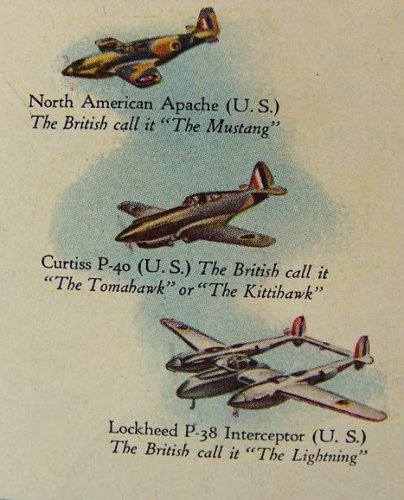 Brit vs. US.jpg82.6 KB · Views: 90
Brit vs. US.jpg82.6 KB · Views: 90 -
USN - Model Designation of Naval Aircraft (3 June 1941, Memo) opt.pdf69.9 KB · Views: 13
-
[US Navy] Navy Press Release - Navy Gives Fighting Names to Planes (1 October 1941) opt.pdf49.7 KB · Views: 13
-
USN - Use of Popular Names for Naval Aircraft (26 July 1961, Memo) opt.pdf43.2 KB · Views: 17
- Joined
- 11 March 2012
- Messages
- 3,244
- Reaction score
- 3,170
Avro Canada CF-100 was officially named Canuck, but many RCAF members called it "Clunk" because it was sub-sonic.
Beech 18 was always "Expeditor."
Bell UH-1 was officially "Iroquois" in Canadian service, but most called it Huey.
Bell 212 was always referred to as "Twin Huey.
Canadair CT-133 Silver Star was always referred to as "T-33."
DHC products are always referred to by name: Tiger Moth, Chipmunk, Beaver, Otter, Cariboo, Buffalo and Twin Otter … with the exception of Dash 7 and Dash 8.
Douglas C-47 was referred to as "Dak," short for the British designation "Dakota."
Lockheed CC-130 is "Herc" or “Hercy Bird."
Beech 18 was always "Expeditor."
Bell UH-1 was officially "Iroquois" in Canadian service, but most called it Huey.
Bell 212 was always referred to as "Twin Huey.
Canadair CT-133 Silver Star was always referred to as "T-33."
DHC products are always referred to by name: Tiger Moth, Chipmunk, Beaver, Otter, Cariboo, Buffalo and Twin Otter … with the exception of Dash 7 and Dash 8.
Douglas C-47 was referred to as "Dak," short for the British designation "Dakota."
Lockheed CC-130 is "Herc" or “Hercy Bird."
Last edited:
panzerfeist1
ACCESS: Secret
I have heard that the Russians at a certain military defense forum got pissed at the NATO reporting name for a certain aircraft, that for revenge they wanted to paint the certain aircraft a certain color and I am not going to elaborate that without getting in trouble here so figure out the rest.
Last edited:
- Joined
- 29 August 2010
- Messages
- 598
- Reaction score
- 298
Probably the same way that "Beaulieu" is pronounced "Byoo-lee".I remember living in Southampton near a place called "Beauvois Valley". Following my schoolboy French I pronounced it roughly like "beau-voir". To locals, it was "Beevis". Its not always obvious how words will be pronounced by the locals.
martinbayer
ACCESS: Top Secret
- Joined
- 6 January 2009
- Messages
- 3,341
- Reaction score
- 3,810
Congratulations, my good Sir, on creating a true null message - your zero contribution to this particular forum thread is very unvalued indeed! And please spare me and the other forum members the drivel that you would have to kill us all if you actually provided any concrete info... On a completely unrelated note, if your screen name is intended to refer to a Nazi anti-tank weapon system development, you truly hit the jackpot with respect to mangling names, because it's *Panzerfaust", see https://en.wikipedia.org/wiki/Panzerfaust. But now, scurry along, my little troll...I have heard that the Russians at a certain military defense forum got pissed at the NATO reporting name for a certain aircraft, that for revenge they wanted to paint the certain aircraft a certain color and I am not going to elaborate that without getting in trouble here so figure out the rest.
Last edited:
- Joined
- 11 March 2012
- Messages
- 3,244
- Reaction score
- 3,170
Grumman originally proposed calling XP-50 “Tomcat” but the US Navy rejected the name as “too sexually suggestive.” The US Navy called it Skyrocket instead.The F5F was not called the Tomcat, it is said to have been the Skyrocket. The name was chosen by the Navy in 1942 when they attempted to give names to all their aircraft (many of which were pretty goofy) and only this one and a couple of others stuck. "Tomcat" may have been Grumman's initial inhouse name for the design, since it has been quoted for the XP-50, and would be in line with the naming every Grumman fighter of the time. …..
A few decades later - into the sexual revolution - the US Navy cheerfully accepted Grumman’s F-14 as “Tomcat.”
See the autobiography of Grumman test-pilot Corky Meyers.
In related news, England tended to assign names to airplanes the the USA only referred to by numbers, hence:
Grumman F4F Wildcat was called “Martlet” in Royal Navy service.
Similarly, Grumman F6F Hellcat was called “Gannet” in RN service.
The first 400 Grumman TBM Avengers delivered to the RN were referred to as Tarpon GR.I while later batches were referred to as “Avengers.”
A Lockheed patrol bomber was called Hudson in RAF service while Douglas DC-3/C-47 was called “Dakota” in RAF service.
Last edited:
- Joined
- 11 February 2007
- Messages
- 2,525
- Reaction score
- 4,275
The US was going through a deeply prudish period when the XP-50 appeared, check the Movie Production Code for the era: https://en.wikipedia.org/wiki/Hays_...ture Production Code,States from 1934 to 1968.Grumman originally proposed calling XP-50 “Tomcat” but the US Navy rejected the name as “too sexually suggestive.” The US Navy called it Skyrocket instead.
A few decades later - into the sexual revolution - the US. Why cheerfully accepted Grumman’s F-14 as “Tomcat.”
The USN names were official. For British names it depends on the variant, the FM2 was the Wildcat F.Mk.VI, with Mks I to V being Martlets. Only the Gannet F.Mk.I was a Gannet, and even they became Hellcat F.Mk.1 in Jan 1944, with all later marks being Hellcats.In related news, England tended to assign names to airplanes the the USA only referred to by numbers, hence:
Grumman F4F Wildcat was called “Martlet” in Royal Navy service.
Similarly, Grumman F6F Hellcat was called “Gannet” in RN service.
Similar threads
-
News: New office to take charge of naming U.S. military aircraft
- Started by fightingirish
- Replies: 0
-
1946 USAAF Penetration Fighter (XF-88, XF-90)
- Started by devi
- Replies: 114
-
If US aircraft numbering systems were never amalgamated
- Started by Abraham Gubler
- Replies: 36
-
"Designating and Naming Defense Military Aerospace Vehicles" (16 May 2014)
- Started by Stargazer
- Replies: 5
-

